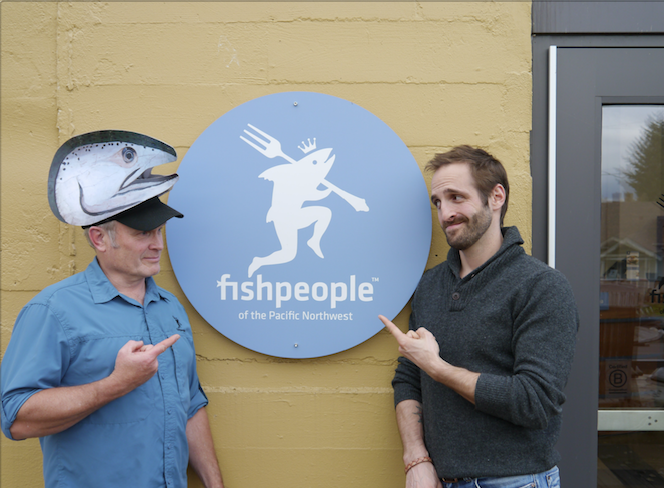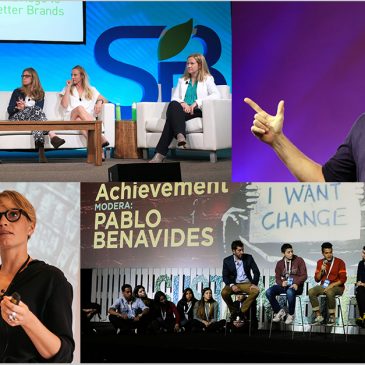Purpose At Work
Purpose At Work: Modern Meadow’s Path To Industry Disruption, Growth and A Sustainable Future

Changemakers don’t have to hold the largest market share. They don’t have to be the highest grossing or have the largest value chain. They do, however, need purpose, vision, drive and a ‘get it done’ attitude. Leaders that show consumers and competitors what is possible earn a reputation as innovators and carve out a competitive advantage.

Fishpeople Seafood is an excellent example of a company leading with purpose to change an industry. I had the opportunity to speak to their Co-Founder, Kipp Baratoff. Here’s what we spoke about.
Simon Mainwaring: So what’s your feeling about the state of the industry?
Kipp Baratoff: The simplest way I can look at seafood today is that it’s organized to reward the few, instead of support the many. So how do we get it to support the many?
For one, today pounds equal pennies. We need them to equal dollars. It’s stuck in commodity economics. Second, quality in our industry is relatively non-standardized compared to most other major commodities.
Put those things together and you get a race for the bottom. You have an industry that’s hell bent on amassing resources and it doesn’t necessarily differentiate based on quality. As a result, your consumer suffers, the oceans suffer and communities that rely on commercial fishing suffer.
When power is concentrated in the hands of a few, small and midscale players who want to build healthy supply chains for high quality fish can’t. That’s not how the industry model works.
SM: How did that motivate you to do something different with Fishpeople?
KB: The industry needs a new story for the 21st century. How do you write that story? You need an alliance of individuals and stakeholders from the consumer all the way down the supply chain. We asked ourselves, ‘How can we work together with others to create it?’ That’s where it started.
We don’t want fishing to become like farming with its almost unintended socioeconomic challenges of putting small scale farmers out of business.
We’re doing that by trying to differentiate our brand based on quality. We’re trying to make pounds equal dollars instead of pennies. We’re working to bring together an army of consumers and supply chain partners that want the industry to evolve. The rising tide lifts all boats.
SM: Walk us through the key players and each of their roles.
KB: You start with NGOs, foundations and civic society. They’re driving change based on policy, regulation and fishery management science. Then you have regulators and policy makers. They could be local, state or federal. So, operating and understanding that group is important. Then you have industry trade groups and consumers. That’s the value chain.
SM: Can you share more about the local community focus?
KB: We had a major fishery collapse in the North Atlantic in 1992. We’re talking about 1% of normal historical stocks. You have counties in Oregon and Washington where 20 plus percent of household income comes from commercial fishing.
Capitalism is born to create wealth with capital production in labor and maximize shareholder profit in the short term. This externalizes a ton of costs. When there’s a collapse, a tragedy of the commons occurs. How do we make sure that doesn’t happen elsewhere?
Figuring out how to get the oceans and rivers healthy is about protecting rural communities. The industry on our coast can actually support many families and create sustainable jobs. It gives you a sense of how far fishing and seafood as an industry has room to grow.
SM: How has becoming a B Corp informed the way you show up as a company for employees, suppliers, marketing and storytelling?
KB: We were the first seafood company certified as a B Corp and we’re proud to be part of that movement. It impacts every piece of our organization from innovation and product development all the way to procurement.
We have nine sourcing principles that govern our approach to buying fish. They ensure our suppliers aren’t doing bad stuff. Then we have employee benefit practices. As a young company, we are trying to optimize for employees in terms of things like a living wage and healthcare benefits that they don’t normally receive.
We give back to our communities, too – these people are our family, friends, all the people we want to see succeed. We’re involved with local sports teams. We’re giving to local vision centers. We’re offering resources to any fishermen and other industry members struggling with addiction or similar hardships
SM: What are some challenges you’ve had on the way that others might learn from?
KB: The biggest learning we’ve had over time is that you can’t do this half-assed. If you’re going to be a purpose driven company, you’ve got to lean in.
Do something you believe in. It’s your compass. Without it you’re going to get lost. It has to be felt by everybody internally and externally.
Our vision has had several manifestations but only one true compass: Do good stuff for fish and do good stuff for people.
Throughout the years we’ve had versions that are short, long, specific, ambiguous, aspirational. And that’s okay. Don’t be afraid to adapt as you find your voice. Also don’t be afraid to define it. That same core primordial spark that started the company is still what’s driving it.
SM: You bringing humor to your voice and give the brand personality. Has it made a difference?
KB: We wanted to be purposeful and playful. In our view, the world needs to play a little more and have fun while we’re solving all these big problems. As opposed to, ‘Oh my God, the weight of the world is on my shoulders, and I feel like Atlas.’
It’s like an energy signature that the founders put on on the company. It’s a fine art between purposeful and playful.
SM: How do you take on an industry that’s larger than yourself, where many of the big players are incentivized to leave things as they are, to cut corners?
KB: You must believe you’re capable of transforming a conventional industry through great product and/or service. Then you need a powerful point of view on how the industry needs to change. That point of view must be integrated into your products and marketing.
That enables you to drive conversation with action versus just talking about what needs to change. There’s a lot of purpose-driven folks that love to theorize about what needs to be different. We want to put it into action. That’s what earns you respect among other influencers. You need to connect the change you seek to the economic drivers of your industry.
Two years ago we merged with another company. In that moment we went from two founders to four founders, a big adjustment for the entire organization.
A prominent Forbes contributor named George Bradt wrote that 83% of all mergers fail. They fail primarily because of culture. He said, “When you merge cultures well, value is created. When you don’t, value is destroyed.” We shared that with the executive team and talked about what that meant for this merger that we were doing.
You put a seafood entity and a brand powerhouse together and you’re building something different. We translate between both industries.Now the brand is sitting on top of a supply chain. It’s creating the change that we’re looking for. How we bring those puzzle pieces together is the heart of what we’re doing as a company.
Two years after that merger, we’re just beginning to see the fruit. It’s been a long and worthwhile journey.
SM: Has the purposeful commitment helped the company grow and scale its impact and leadership?
KB: It’s increased employee engagement. Engagement is often a monitor for productivity. Every new hire goes on a two-day tour of the facilities. When you immerse yourself that way you just understand the danger level and the excitement. What you’re trying to do becomes visceral. You can feel it in your belly.
From there it helps throughout the value chain. It strengthens the ‘why’ and helps with sales. We’ve brought customers. We’ve brought investors.
We believe you can see uplift in velocity when you include it in branding and marketing. When you have a purpose-driven brand that’s delivering great products and adding wonderful storytelling, you begin to disrupt categories. You create change that’s deeply meaningful. You can send that signal back through the supply chain
Simon Mainwaring: What would you say to companies, in the seafood industry or not, that are sitting on the sidelines wondering whether they should be purposeful
Kipp Baratoff: People are increasingly voting with their wallets. They want to know what brands stand for. It builds trustworthiness. Purpose-driven messaging is better at driving advocacy than other forms of messaging.
It helps build a strong culture and increase recruitment, development and retention. I would say get on the bus because there’s always practical, tangible business benefits for you. You’re missing out if you don’t do it right.

Purpose At Work: Modern Meadow’s Path To Industry Disruption, Growth and A Sustainable Future

The We First Guide to SB’17 Detroit
Brands Call Bullsh*t On Their Competitor’s Alternative Energy Storytelling

